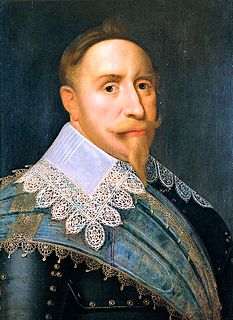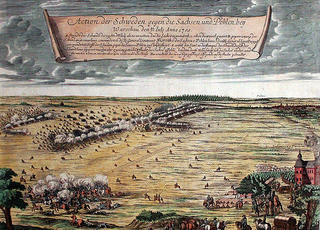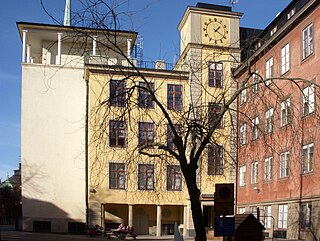Related Research Articles

John II Casimir was King of Poland and Grand Duke of Lithuania from 1648 until his abdication in 1668 as well as titular King of Sweden from 1648 until 1660. He was the second son of Sigismund III Vasa and Constance of Austria. His older brother and predecessor on the throne was Władysław IV Vasa.

The term Deluge denotes a series of mid-17th-century campaigns in the Polish–Lithuanian Commonwealth. In a wider sense it applies to the period between the Khmelnytsky Uprising of 1648 and the Truce of Andrusovo in 1667, thus comprising the Polish theatres of the Russo-Polish and Second Northern Wars. In a stricter sense, the term refers to the Swedish invasion and occupation of the Commonwealth as a theatre of the Second Northern War (1655–1660) only; in Poland and Lithuania this period is called the Swedish Deluge, or less commonly the Russo–Swedish Deluge due to the simultaneous Russo-Polish War. The term "deluge" was popularized by Henryk Sienkiewicz in his novel The Deluge (1886).
The Polish–Swedish Wars were a series of wars between the Polish–Lithuanian Commonwealth and Sweden. Broadly construed, the term refers to a series of wars between 1563 and 1721. More narrowly, it refers to particular wars between 1600 and 1629. These are the wars included under the broader use of the term:

The Union of Kėdainiai was an agreement between several magnates of the Grand Duchy of Lithuania and the king of the Swedish Empire, Charles X Gustav that was signed on 20 October 1655, during the Swedish Deluge of the Second Northern War. In contrast to the Treaty of Kėdainiai of 17 August, which put Lithuania under Swedish protection, the Swedish-Lithuanian union's purpose was to end the Lithuanian union with Poland and to set up two separate principalities in the Grand Duchy of Lithuania.

The Deluge is a historical novel by the Polish author Henryk Sienkiewicz, published in 1886. It is the second volume of a three-volume series known to Poles as "The Trilogy," having been preceded by With Fire and Sword and followed by Fire in the Steppe. The novel tells a story of a fictional Polish–Lithuanian Commonwealth soldier and noble Andrzej Kmicic and shows a panorama of the Commonwealth during its historical period of the Deluge, which was a part of the Northern Wars.

The Polish–Swedish War (1600–1611) was a continuation of struggle between Sweden and the Polish–Lithuanian Commonwealth over control of Livonia and Estonia, as well as the dispute over the Swedish throne between Charles IX of Sweden and Sigismund III of Poland.

The Polish–Swedish War of 1621 to 1625 was a war in a long-running series of conflicts between the Polish–Lithuanian Commonwealth and the Swedish Empire. It began with a Swedish invasion of the Polish–Lithuanian fiefdom Livonia. Swedish forces succeeded in taking the city of Riga after a siege. The Commonwealth, focussed on war with the Ottoman Empire, was unable to send significant forces to stop Gustav Adolf, and signed a truce favorable to Sweden. The Commonwealth ceded Livonia north of the Dvina (Düna) river, and retained only nominal control over Riga. The new truce in Mitau was signed and lasted from November 1622 to March 1625.
The Polish–Swedish War of 1626–1629 was the fourth stage in a series of conflicts between Sweden and Poland fought in the 17th century. It began in 1626 and ended four years later with the Truce of Altmark and later at Stuhmsdorf with the Treaty of Stuhmsdorf.

The Battle of Jakobstadt was a battle fought in the Great Northern War. It took place on 25 July 1704 (O.S.) / 26 July 1704 / 5 August 1704 (N.S.) between a Swedish army under Adam Ludwig Lewenhaupt and a combined Lithuanian/Russian force under Great Hetman Michał Serwacy Wiśniowiecki at the town of Jēkabpils in the Duchy of Courland and Semigallia. The Swedes were victorious.

Sweden–Ukraine relations are foreign relations between Sweden and Ukraine. Diplomatic relations between the two countries were established on 13 January 1992. Sweden has an embassy in Kyiv and an honorary consulate in Kakhovka. Ukraine has an embassy in Stockholm.
The Battle of Kokenhausen was a major battle opening the Polish–Swedish War (1600–1611). It took place on the 13 June (O.S.) or 23 June (N.S.) 1601 near Koknese in Livonia. In the battle, Polish forces defeated the Swedish relief force and captured the besieging force, relieving the Polish garrison. The battle is notable as one of the greatest victories of the Polish hussars, who defeated their numerically superior Swedish adversaries.

The Battle of Warsaw was fought on 31 July 1705 near Warsaw, Poland, during the Great Northern War. The battle was part of a power struggle for the Polish–Lithuanian throne. It was fought between Augustus II the Strong and Stanisław Leszczyński and their allies. Augustus II entered the Northern war as elector of Saxony and king of the Polish–Lithuanian Commonwealth, and had formed an alliance with Denmark–Norway and Russia. Stanisław Leszczyński had seized the Polish throne in 1704, with the support of the Swedish army of Charles XII of Sweden. The struggle for the throne forced the Polish nobility to pick sides; the Warsaw Confederation supported Leszczyński and Sweden, and the Sandomierz Confederation supported Augustus II and his allies. The conflict resulted in the Polish civil war of 1704–1706.

Lithuania–Sweden relations are the foreign relations between Sweden and Lithuania. Sweden has an embassy in Vilnius. Lithuania has an embassy in Stockholm.

Swedes are a North Germanic ethnic group native to the Nordic region, primarily their nation state of Sweden, who share a common ancestry, culture, history and language. They mostly inhabit Sweden and the other Nordic countries, in particular Finland, with a substantial diaspora in other countries, especially the United States. Swedes are an officially recognized minority in Finland and Estonia.
The Battle of Olkieniki took place at March 6, 1706 close to the town of Olkieniki in the Polish–Lithuanian Commonwealth during the Great Northern War.

Estonians in Sweden, alternatively known as Estonian Swedish people are Swedes of full or partial Estonian descent residing in Sweden. In 2020, there were 9,606 people living in Sweden born in Estonia.
Germans in Sweden, alternatively known as German Swedish people are Swedes of full or partial German descent residing in Sweden. In 2020, there were 51,434 people living in Sweden born in Germany.

Swedes constitute a considerable ethnic group in Chicago, where a little over 15,000 people are of Swedish ancestry.

The Battle of Tryszki, Tryškiai or Triski, on December 14, 1701, was a small engagement between Swedish forces under Charles XII of Sweden and Polish–Lithuanian forces under Grzegorz Antoni Ogiński, in the town of Tryszki (Tryškiai), Samogitia. After the Crossing of the Düna Charles went into an alliance with the Sapieha family to gain his support in dethroning Augustus II the Strong from the Polish throne, in exchange for protection from rival families in Samogitia, such as the Ogiński family. After initial engagements between Swedish forces and those loyal to Grzegorz Antoni Ogiński, the Swedish king personally takes command of the troops and engages Grzegorz at the town of Tryszki; after a brief encounter, Grzegorz is forced on the run and, with Charles being hot on his heels, eventually retreats out of Samogitia altogether. A Swedish detachment is established at Wilno (Vilnius) in Lithuania, as a sort of forward operating base before the inevitable Swedish invasion of Poland (1701–1706); further engagements, foremost the Battle of Darsūniškis, confirms the Swedish invasion. Although only a small action in a major war, the battle quickly sparked false rumours to be spread around Europe; one spoke of the death of Charles, somewhere in Lithuania, while the other mentioned a major defeat for Grzegorz, involving many thousands of participants.
Latvians Swedes, alternatively known as Latvian Swedish people are Swedes of full or partial Latvian descent residing in Sweden. In 2020, there were 8,798 people living in Sweden born in Latvia.
References
- ↑ "Folkmängden efter födelseland, ålder och kön. År 2000 - 2020". Statistikdatabasen. Retrieved 2021-09-17.
